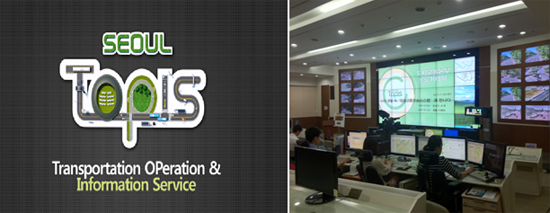
Overview
The Transport Operation and Information Service (TOPIS) of the Seoul Metropolitan Government is the “control tower” for Seoul City’s transportation system. It automatically triggers an alarm system in case of an emergency and inform all concerned parties; police stations, bus operators and citizens. By gathering and processing the city’s road traffic and subway train information real-time, the city mow efficiently manages the interval between buses, relieves congestion and takes timely action in case of an accident.
Features
Real-time monitoring of traffic and information The TOPIS provides real-time traffic information 24 hours per day throughout the year. By linking 741 CCTVs in the city, it can figure out traffic conditions of major roads at a glance and share the road control and congestion information, such as if there is any accident, roadworks and protest rallies, with the Seoul Police Agency and the TBS. Citizens can also check any outbreak of unexpected situations through the city’s website, mobile-apps, and SNS (Twitter, etc.).
BMS; Bus Management System for more scientific operation of intra-city buses The system, utilizing satellite technology, innovated Seoul city’s bus operations (9,400 vehicles and 610 routes), leading to a significant increase in punctuality and accuracy of the operation intervals.
Real-time information on public transportation operation (subway, bus) Citizens now benefit from real-time traffic information including arrival times on bus routes and bus stops, subway operation through various means, e.g. the Internet, mobile devices, BIT, and QR code. As the city now even allows private developers to utilize the information, the service has become truly ubiquitous.
Outcomes/Achievements
Bus users: Rising customer satisfaction Users’ satisfaction level has risen with the real-time bus operation information available. They gave high marks to the service quality improvement as they feel more comfortable with even intervals and safer driving and no longer have to wait much thanks to the arrival time information
Bus companies: Growing number of passengers boosts the profitability The regular intervals and predictable arrival times attracted more passengers to buses and, with bigger control over drivers’ speeding and aggressive driving, there are now less accidents and shrinking insurance premiums. All these improvements lead to higher profitability. Above all, the bus companies are now able to regulate illegal operation e.g. passing by a bus stop without stopping, and the service quality has boosted as well.
Seoul Metropolitan Government: reinvigorated public transportation With the operation becoming more convenient and easily accessible, the city has regained public trust. The advanced science utilized in the system has reinforced accuracy, objectivity and profitability in the management of the bus system. The exclusive median bus lane system run in parallel also contributed to greater punctuality of intra-bus operation, while the city’s efforts to take swift action against illegal operations has encouraged drivers to comply with the regulations, too
Cost
The global budget’s amount is approximately KRW 200 billion (around 188,000 USD). As the city was the first local government in the nation to develop such an intelligent transportation system (ITS), the project commenced in 1998 entirely financed by the municipal budget, without any support from the central government. However, the benefits of the system soon became known to other local governments, and the central government came to recognize the need, so some of the city’s additional projects are now subsidized by the state on a 50-50 basis.
Inquires
Global Urban Partnership Division of the Seoul Metropolitan Government (international@seoul.go.kr)
Related Links
https://seoulsolution.kr/?language=en

